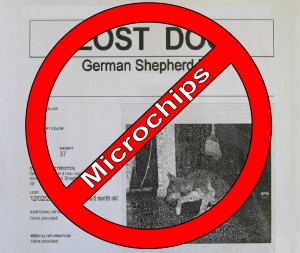What is a Microchip and Should I Consider It for My Pet?
 I’m sure at some point, you have driven down a neighborhood street and seen a flier hanging on a telephone pole with a picture of a pet with the word “Missing” above it. If you participate in social media, you have probably seen the countless photos of pets that have gone missing flooding your screen. You can open up the newspaper in the pets section and find ads for lost or missing pets almost every single day. My heart breaks for these families. A part of their family has disappeared and every effort is being made to try and get them home. But what happens when they are found? Although tags and collars may offer identification, it is always a possibility that they managed to slip out of their collar, that tags fell off, or possibly did not even have one on in the first place. Even though Fluffy is an indoor only cat, or Fido is a loyal, well trained dog who always stays in the yard, accidents happen. Maybe you thought you closed the door on your way outside, but Fluffy decided to sneak through the crack. Perhaps Fido has had enough of that squirrel taunting him and finally decides to jump the fence and take chase. When they are found, a microchip is a great way to get Fluffy and Fido back home again.
I’m sure at some point, you have driven down a neighborhood street and seen a flier hanging on a telephone pole with a picture of a pet with the word “Missing” above it. If you participate in social media, you have probably seen the countless photos of pets that have gone missing flooding your screen. You can open up the newspaper in the pets section and find ads for lost or missing pets almost every single day. My heart breaks for these families. A part of their family has disappeared and every effort is being made to try and get them home. But what happens when they are found? Although tags and collars may offer identification, it is always a possibility that they managed to slip out of their collar, that tags fell off, or possibly did not even have one on in the first place. Even though Fluffy is an indoor only cat, or Fido is a loyal, well trained dog who always stays in the yard, accidents happen. Maybe you thought you closed the door on your way outside, but Fluffy decided to sneak through the crack. Perhaps Fido has had enough of that squirrel taunting him and finally decides to jump the fence and take chase. When they are found, a microchip is a great way to get Fluffy and Fido back home again.
When activated by a microchip reader, a pet’s microchip transmits a tiny frequency which is then read by the microchip reader. The reader provides a unique identification number that can be used to look up information that has been registered to that chip. It is important to know that the chip does not work as a GPS. In other words, the chip does not tell you where your pet is located when they escape, rather it only provides information as to how the person who read the chip may contact you when the pet is found and scanned. The chip itself is small, about the size of a grain of rice. The standard location for implantation is under the skin in the area between the shoulder blades. Although the size of the needle may look intimidating to us, but pets are brave and do not need to be anesthetized to have the chip implanted. The microchip does not require a battery to operate and is a permanent form of identification, functioning the entire life span of your pet.
Many veterinary practices will register your microchip information for you once the chip has been implanted. What that means is that your contact information (address, name, phone number, etc.) will be entered in a database should your pet ever need to have its chip scanned. However, it is your responsibility to keep your contact information current. The shelter can’t return Fido back home to you if your phone number or address is not correct. Keeping information up to date can be easily be completed by contacting the manufacturer of your pet’s microchip. Another perk to microchipping dogs is the availabilty of a lifetime dog license. In Pennsylvania there is a one-time fee for pets with microchips that saves you the worry of trying to remember to renew it every year.
Linda K. Lord, DVM, PhD, an assistant professor in the Department of Veterinary Preventive Medicine, at The Ohio State University published a study in 2008 that looked into the number of cats and dogs that entered shelters and were returned home with the aid of a microchip. The study showed some pretty impressive numbers. To summarize the results, the study (cited by Lord) found that 73% of stray animals that had been turned in to shelters, had owners that were able to be located. The study (cited by Lord) also found that dogs that were microchipped, compared to stray dogs that were not, had a return-to-owner rate that was 2.4 times higher. Cats that were microchipped were 21.4 times higher than those cats that were not. There have even been reports of family pets that had been missing for months and years, only to be found hundreds of miles away, and all thanks to a microchip. Situations (cited by Lord) such as incorrect phone numbers, owner’s not returning the shelters calls, unregistered chips and registered chip numbers not correlating to the manufacturer’s product were found to be the top reasons that pets with microchips were not able to be returned to their owners.
With those numbers, it is easy to see the benefits of micropchipping your pets. Although microchipping is a great form of permanent identification, it is always a good idea to keep a collar on your pet that has you contact information easily visible. A little microchip can make the difference if you will find your lost pet. It’s a decision you will have been glad you made if you ever find yourself in that position. If you are interested in getting your pets microchipped, please call our office where we could get you scheduled or answer any additional questions you may have.
Resource:
Lord, Linda K. DVM, PhD, Assistant Professor, Department of Veterinary Preventive Medicine, The Ohio State University. (2008). The Microchip World: Recent Advances and Options for Shelters and Veterinarians. The Ohio State University College of Veterinary Medicine The Indoor Pet Initiative. 3/31/2014, from http://indoorpet.osu.edu/veterinarians/microchip/index.cfm
